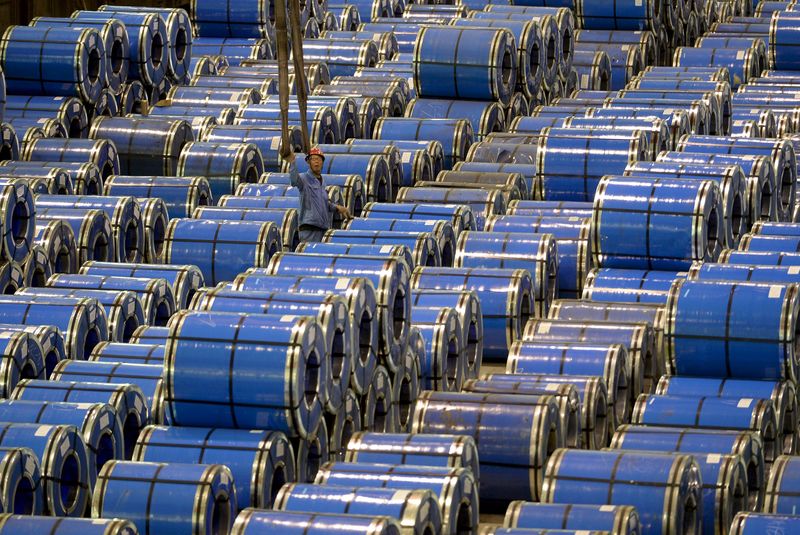* Graphic on China's economy, trade: http://tmsnrt.rs/2iO9Q6a
By Clyde Russell
LAUNCESTON, Australia, July 24 (Reuters) - Anybody looking at the United States' import data would wonder why the Trump administration is bothering making a big deal out of its steel trade with China.
U.S. President Donald Trump said last week that he is considering imposing tariffs on steel imports, while talks between the commerce secretaries of the United States and China ended without any concrete measures. The threat of U.S. import taxes on Chinese steel have helped boost the share prices of U.S. steelmakers, but this is likely more of a sentiment driven improvement rather than any expectation that imposing tariffs will be anything more than largely symbolic.
While China is the world's largest producer of steel, and has emerged as a major exporter in recent years, the simple truth is that very little of its output reaches the United States.
U.S. Commerce Department statistics show that China supplied 73,594 tonnes of steel in May, a tiny 2.4 percent of the 3.12 million tonnes imported by the United States that month.
China's exports to the United States also represented just 1.05 percent of its total steel product exports in May of 6.98 million tonnes.
China was the 10th largest supplier of U.S. steel product imports in May, which is actually a drop of one spot since May last year, when it was ninth.
In the first four months of 2017, U.S. imports of Chinese steel products were 236,690 tonnes, representing 2.1 percent of total imports and down from 283,676 tonnes for the same period last year.
What the U.S. import data reveals is that if there is a problem with too much imported steel, China is definitely not the source of that problem.
If Trump wants to boost the U.S. steel industry by cracking down on imports, he should focus much closer to home, with Canada supplying 514,488 tonnes in May and Mexico 266,544.
China isn't even the biggest supplier of steel from Asia, being behind Japan, South Korea and India in May and only just ahead of Taiwan.
If the Chinese are dumping steel into the U.S. market, the only reasonable conclusion that could be reached is that they are remarkably bad at doing so, given their miniscule market share, and their seeming inability to grow it.
CHINA'S EXPORTS
Chinese steelmakers are also struggling in other markets, with exports in the first five months of the year totalling 34.18 million tonnes, down 25.7 percent on the same period in 2016, according to official customs data. is made of China's steel behemoth swamping the rest of the world, but the reality is maybe not quite as threatening as made out.
No doubt China's steel sector is huge, accounting for more than half of global production, but this is largely consumed domestically.
Steel output rose 5.7 percent in June from the year-earlier month to 73.23 million tonnes, the highest on record and beating April's 72.78 million, the previous high. the first half of this year, Chinese steel production was 419.75 million tonnes, up 4.6 percent on the same period in 2016, according to official data released on July 17.
But this record level of steel production isn't causing a glut in China, where prices are performing well.
The main Shanghai rebar contract SRBcv1 closed at 3,506 yuan ($518.64) a tonne on July 21, up 32 percent since the end of last year.
It's possible that some of the price surge can be attributed to speculative investors, but China's solid growth performance does provide some fundamental justification, with the economy expanding by 6.9 percent in the second quarter, slightly ahead of market expectations.
Chinese steel producers are likely becoming more efficient as well, as older, more expensive plants are closed as part of Beijing's efforts to cut steel capacity by as much as 150 million tonnes.
While the United States and others, such as the European Union and India, have made noises about unfair competition from China, these arguments may be getting harder to sustain in the light of China's falling steel exports and seeming success in eliminating excess capacity.
<^^^^^^^^^^^^^^^^^^^^^^^^^^^^^^^^^^^^^^^^^^^^^^^^^^^^^^^^^^^ Graphic on China's economy
http://tmsnrt.rs/2iO9Q6a
^^^^^^^^^^^^^^^^^^^^^^^^^^^^^^^^^^^^^^^^^^^^^^^^^^^^^^^^^^^> (Editing by Christian Schmollinger)
